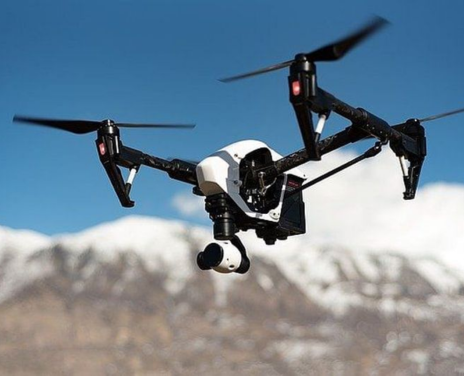Following the April 2025 Pahalgam Attack and similar worrying threats, India seems to be adapting its security strategy for Jammu and Kashmir. The new addition to India’s surveillance system: AI powered drones.
From the future to the present, the new autonomous aerial vehicles now stationed over the most sensitive areas of India safeguard the region. Unlike traditional drones which are armed with missiles, these next-gen security drones are equipped with real-time data, high-resolution sensors, and intelligence, thus capable of truly next generation surveillance: efficient, responsive, and tireless.
A new turning point in the aftermath of Pahalgam
On April 22 2025, a terrorist attack in Pahalgam not only stirred the nation with the loss of 26 civilian lives, but further emphasized the shortcomings in ground surveillance systems. Post attack, Indian security forces tripled their troop deployment to the region and employed the use of artificial intelligence and unmanned aerial systems for enhanced situational awareness.
The Kashmiri mountains, deep forests, and valleys: perfect for hiding, but deadly for human patrols and fixed position checks. With the addition of AI drones, there is now aerial surveillance that not only enhances view of the region, but greatly improves preemptive defense and quick threat neutralization.
The Use of AI Drones in Monitoring and Security
1. Machine Learning and GPS Technologies for Patrols
Drones stationed in Kashmir ai automates their patrols using GPS and machine learning. The drone’s flight can be either along predetermined routes or they can pivot as per detected movements.
They are capable of spotting movement and tracking vehicles. They can also identify abnormal activity like off-hour night movement in restricted areas and flag it in real-time for command centers.
2. Suspicious Activity Identification and Classification
In addition to groundbreaking surveillance, these drones are trained using computer vision models to identify:
- Unauthorized movement such as loitering and suspicious activity
- Armed suspects and suspicious cargo
- Insurgents camouflaged within thick forestry
With these capabilities, drones are able to make rapid responses where it is absolutely essential without overwhelming filters for true positives.
3. Thermal Cameras for Patrols at Night
Night systematized patrols are heavily reliant on manual vision apparatus which have a lack of reliability in rough terrains. Drones employed with thermal cameras along with night vision monitoring of movement is possible even in total darkness. AI drones can detect even the faintest of movements, alone crossers at the Loc or sudden multi-person gatherings near sensitive areas, they spot them instantly.
4. The Indrajaal Drone Defense Dome
Among the impressive Indrajaal systems of AI defense India is integrating is Grene Robotics’ autonomous counter-drone dome system which can protect 4,000 square kilometers of territory and utilizes AI enabled detection and neutralization systems for incoming hostile drones.
Indrajaal functions as an automatic shield within the Kashmir region harnessing the power of electronic warfare and drone neutralization technologies, Indrajaal automatically detects and disables enemy drones, jammers, and payloads which are moved without the need of human intervention, freeing up operators and is able to function in a mostly autonomous mode.
5. Data Fusion and Predictive Policing
Drone surveillance of the Indian Army encompasses more than just real-time video footage. The Army employs data fogging techniques which combine data from various sources or documents. AI capabilities are tasked with processing:
- A live feed from the drone
- Social media activities
- Reports from the ground
- Sensor data from fencing and radars
All this information is processed through predictive AI models capable of estimating the probabilities of attacks during a certain period of time, possible routes of entering the area, and analyzing the movements of specific known insurgents. This enhances the algorithm’s core purpose which is intelligence and intelligence itself along with the deployment of troops and their resources is much better optimized.
Proactive Technology and Human-Centric Security
Drones may be machines, but their purpose is profoundly empathetic: preserving life, bringing back hope, and ensuring safety for the citizens of Kashmir. The use of AI drones has already facilitated the early detection of potential threats, which enables proactive intervention by security forces before damage occurs.
Moreover, these drones minimize the risk to personnel by performing first response reconnaissance, particularly in risky or ambush-prone regions.
Balance of Privacy and Ethics: The Struggle
All AI-enabled surveillance technologies bring issues of privacy and civil liberties to the forefront. Indian defense officials have guaranteed that drone usage is limited to high-risk zones and border areas, while civilian profiling is strictly avoided as AI models focus exclusively on threat recognition.
There are also ongoing efforts to maintain ethical AI frameworks, ensuring surveillance operates within the bounds of necessity and is constantly supervised through routine audits.
A Vision: An All-Inclusive Security Grid
The integration of AI drones into India’s defense system is just the beginning of a complex, multi-tiered AI integration. In the near future, we can expect;
- Cooperative AI behavior swarm drones designed to surveil and patrol large areas
- 5G Networks Integration for Advanced Data Transfer Speed
- The ability to identify threatening elements through AI voice recognition of language patterns within collected communications.
Conclusion
Kashmir’s AI drones don’t just scan the area—they represent an advance paradigm of security technologies designed to protect India with unparalleled efficiency while ensuring minimal intrusion within its borders, thus fostering peace.
With the advancement of AI comes the great potential to aid in national security and the inevitable shifts in our responses. One stark remains clear: we’re shifting from an era of blind spots and slow reactions to a sharper, swifter, and supremely intuitive barrier—India—from above.


